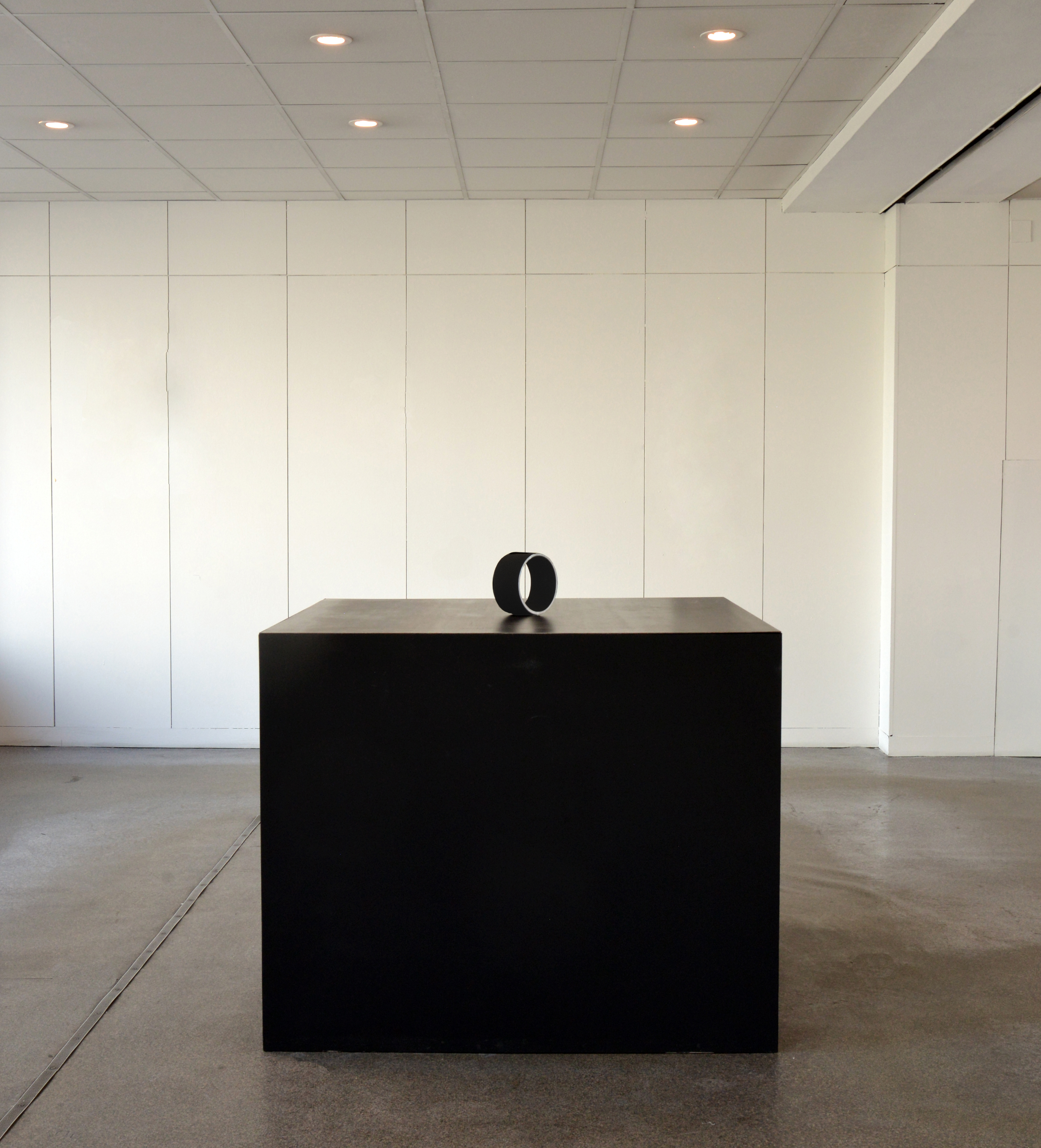Planet Caravan
Sculpture. 2018.
Base: wood, steel, 121 x 121 x 121 cm.
Ring: iron, eight layers of SingularityTM Black, 20 x 20 x 10 cm

Photos: Amélie Laurence Fortin
Exhibition text
In September 2016 Vantablack, a new carbon-based paint dubbed the “blackest black” was exclusively licensed to Anish Kapoor's studio for artistic use, sparking outrage among artists including painter Christian Furr who said that he felt Kapoor was monopolizing the material. “Using pure black in an artwork grounds it," he said “and all the best artists have had a thing for pure black - Turner, Manet, Goya”.
Soon after it was Stuart Semple who put himself at the forefront of this backlash. In retaliation, Semple banned Kapoor from buying the "world's pinkest pink" a strong shade of colour Semple had developed. Purchasers were required to make a legal declaration confirming that they "are not Anish Kapoor, are in no way affiliated to Anish Kapoor, and are not purchasing this item on behalf of Anish Kapoor or his associates”. Still, Kapoor has managed to get a hold of some in what was described as "one of the most spectacular displays of pettiness seen in recent years" and announced the fact via a famous picture on his Instagram account showing his middle finger dipped in the paint, captioned "Up yours #pink." Then Semple barred Kapoor from buying other products of his, including acrylic paint sold as Black 2.0 and Diamond Dust, the “most glittery glitter” made from flakes of glass. In 2017 a Massachusetts manufacturer under contract to NASA partnered with artist Jason Chase to release black paint called Singularity Black, named so to reference the centre of a black hole. Unlike Vantablack, Singularity has been made available to the general public, with the company offering coating for anyone who sends in artwork to their lab as well as Singularity School classes for those interested in painting their works themselves. Funnily Kapoor has only made a few works using his prohibitively expensive Vantablack. That rendered the situation to a really meta, if somewhat absurd level.
Comfortingly there is more to this than meets the eye. Being the blackest of materials, both Vantablack and Singularity have a number of remarkable applications in astrophysics, for the sprayable uncannily dark substances prevent stray light from blinding telescopes, and improve the sensitivity of terrestrial, space and air-borne instrumentation such as satellite cameras making it possible to see even the oldest and faintest stars. In cosmology, the singularity is considered the earliest stage of the Big Bang despite that currently there is no available theory to describe these short times, and it is not clear in what sense the concept of time is still meaningful for incredibly small periods. Similarly, the space singularity is a region in which the density of celestial bodies becomes infinite and therefore the conventional laws cannot exist and break down, just like in the centre of black holes from where nothing, not even light can escape. While it’s unclear whether singularities exist or existed at the start of the Universe, or if our current knowledge is simply insufficient to describe what happens in such extreme conditions, in her recent works created with the assistance of experts who contributed to the development of her research on scientific theorems, A.L.Fortin examines the relationship between humans and nature, all the while maintaining the intensity of natural phenomena. The very notion of void-like experience which makes black objects look almost featureless and primal indeed appears profoundly moving and captivating in the same vein it is rewarding to acknowledge that ultimately we sail through endless skies on a tiny rock in the outskirts of a galaxy travelling across the vast expanse of space at an ever-increasing velocity far exceeding what is plausible.
-Paweł Kamiński, autor
EXHIBITED
Poznan Art Week, Redystrybucja, Dom Książki, Poznan, Pologne, 2018 -WEBSITE
Axenéo7 gallery, Gatineau, Canada, 2018
ACKNOWLEDGMENTS /// Conseil des arts du Canada, Mateusz Bieczyński, Uniwersytet Artystyczny w Poznaniu (UAP), NanoLab, Stefan St-Laurent.